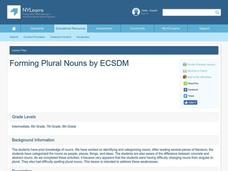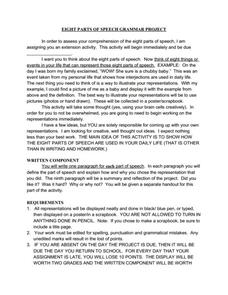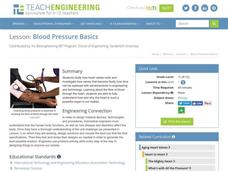Curated OER
Forming Plural Nouns
Everyone knows that a noun is a person, place, thing, or idea - but what happens when you have people, places, things, or ideas? Use this SMART board activity to guide your class through plural nouns. Several activities, including making...
Curated OER
Who is the Expert? Exploring Credible Sources in Healthcare
How do you decide what sources are credible when researching online? Evaluate sources with a focus on researching health issues. After brainstorming common health concerns and how they would try to diagnose these problems, class members...
Curated OER
Water in the Biosphere
Environmental explorers examine the campus and take note of living organisms. Introduce them to the biosphere and the questions of the day: How much water can be found in the biosphere? A slide show helps you along, and even contains a...
Huntington Library
Further Exploration - Exploring the California Missions
How did Native Californians and Franciscans influence one another in early California? Learners analyze a few cultural pieces to examine the impact that integration had on Franciscan and Native Californian culture.
US Department of Agriculture
Agriculture Counts
Agricultural survey and the documentation of livestock or goods was the basis for the first written language. Youngsters discuss sorting and counting, and how these skills have been used for thousands of years. They accent their class...
Curated OER
Compliments and Feelings
How do you feel when you get a compliment? Give a compliment? After modeling how to make explicit compliments (“I like the way . . .”) ask class members to practice saying nice things about themselves and others, and to consider how...
Curated OER
Lesson: Urs Fischer: Reviving the Past Art Movements
Seven major abstract art movements are analyzed by learners in groups. Each group analyzes various works by determining which work belongs to which movement. They then read Flatland, engage in an art and literary analysis discussion,...
Curated OER
Fast and Slow Motion
Explore the world of motion and force with an activity for kindergarten and first grade. After determining how people can make balls or bikes move slower, kids use a cardboard tube and a marble to experiment with motion and speed. A...
Curated OER
Lesson: Urs Fischer: Controlling our Logic, Metaphors, and Semantics
Kids use poetry and contemporary art to start thinking about logic and personal expression. They read Sylvia Plath's poem "Metaphor," and critically examine the art of Urs Fischer. After working though a few logic problems they write...
SF Environment
Pre-School Composting and Recycling!
You can never be too young to get involved in composting or recycling. Here is a lesson that has been made for the very littlest learners and it's all about the importance of conservation. They'll sort compostable and recyclable objects,...
G. Turrell
Science Activity 2: Light & Sound
Little learners experiment with sunlight and map out how light travels. Using a mirror and slotted card, they find out about items that can reflect or absorb the light. They experiment with a variety of materials to find out how light...
Curated OER
Growing Up
Help little learners understand what happens during the human life cycle. Each slide defines and poses discussion questions regarding each phase of human life. Infancy, childhood, the teen years, adulthood, and old age are all covered....
Hawaiʻi State Department of Education
Changing Scapes
Culture and art are two things that change with time and context. Learners compare and contrast two landscape prints from different time periods. They work through art terminology to help them describe what they see in each piece. The...
Virginia Department of Education
Weather Patterns and Seasonal Changes
Get your class outside to observe their surroundings with a lesson plan highlighting weather patterns and seasonal changes. First, learners take a weather walk to survey how the weather affects animals, people, plants, and trees during...
Curated OER
A Handmade House Book with Student Writing
Use this lesson for your bookmaking project. First, young writers work on making an accordion fold house book. After composing a variety of pieces of writing, they can use their book to store their writing. The structure is ideal for a...
Independence Middle School
Eight Parts of Speech Grammar Project
Young grammarians demonstrate their understanding of the eight parts of speech by creating a scrapbook that uses personal stories and photos to illustrate each term. After defining a term, individuals relate and illustrate a personal...
Huntington Library
Everyday Life - Exploring the California Missions
Young scholars relive history as they examine primary sources that document everyday life in the California missions. During a class viewing of the included slideshow presentation, children analyze documents, paintings, and drawings in...
San Francisco Public Utilities Commission
Pesky Plastics: The Problem with Plastic
What can happen to the environment if plastic continues to pollute it? Learners read about the implications of plastic on health, water, and nature in a two-page reading passage. After they finish reading, they work on six comprehension...
Virginia Middle School Engineering Education Initiative
Save the Penguins: An Introduction to Thermodynamics and Heat Transfer
Heat things up in your physical science class with this interactive lesson series on thermodynamics. Through a series of class demonstrations and experiments, young scientists learn how heat is transferred through conduction, convention,...
Houghton Mifflin Harcourt
Surprise!: English Language Development Lessons (Theme 2)
Surprise! is the theme of this series of ESL lessons. Cover an array of topics such as where we live, different times of day, shapes, the city and the country, what we do for fun, jobs, and games, all while practicing how to express...
Teach Engineering
Blood Pressure Basics
Under pressure! The second lesson of the series introduces the class to blood pressure and the impact of high blood pressure on the cardiovascular system. It helps learners make the connection between blood pressure and how the heart...
Code.org
Introduction to Arrays
How can you store lists in a computer program? The 16th installment of a 21-part unit introduces arrays as a way to store lists within a variable. Individuals program a list of their favorite things—adding interest to the activity.
Curated OER
Electricity
Learners explore where electricity comes from and how it is used in their everyday lives. Through discussion and hands-on activities, they define electricity and explain how it travels to our homes. Students make informed choices based...
Curated OER
Promote Nonviolence
Take a look at the topic of violence as seen in Harper Lee's To Kill a Mockingbird. Discuss together the values that Atticus holds and brainstorm ways to combat violence in a similar manner to what he portrays in the novel. Get your...
Other popular searches
- How Things Work Lenses
- How Things Work Toaster
- Explaining How Things Work
- How Things Work" Odometer
- Explanation How Do Things Work
- How Things Work Odometer
- "How Things Work" Odometer

























